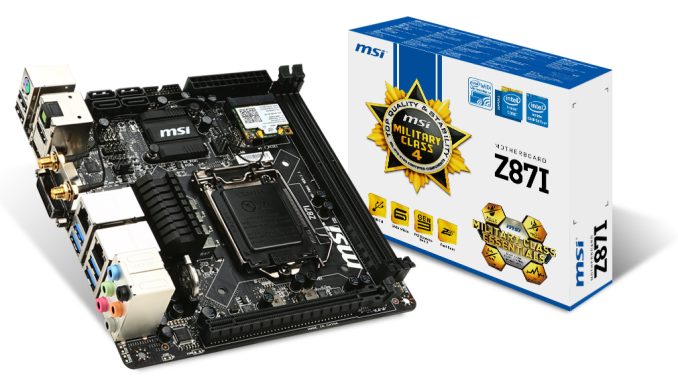MSI Z87I Review: Mini-ITX Haswell for $140
by Ian Cutress on August 27, 2013 10:15 AM EST- Posted in
- Motherboards
- MSI
- Mini ITX
- Z87
MSI Z87I Conclusion
Making small motherboards is almost becoming an art form – the manufacturers have to ensure that in this small form factor they offer enough functionality to remain competitive, but there is an upper limit to pricing which users will find ‘reasonable’ when deciding to choose which motherboard is worth purchasing. MSI have gone down the network connectivity route with the Z87I, featuring dual Realtek NICs and a 2.4 GHz N-2230 802.11n WiFi solution.
Unfortunately, this is where the main problem starts – having a single band WiFi solution in 2013 is a big no-no, especially when dual band 802.11ac is starting to get into the higher end of the Z87 spectrum. At this point in time I am willing to say ‘Dual Band’ or not at all, as a sole 2.4 GHz solution performs poorly in a modern environment with many APs in the local vicinity. This is partly compounded by MSI’s decision for two antennas ‘fixed’ to the rear IO. Although the user can select the direction, the antenna provided do not allow for movement away from the rear panel, meaning users will have to have good coverage in the home.
The motherboard does come with four SATA 6 Gbps ports and two USB 3.0 ports, and I was pleasantly surprised with the use of single side latch DIMM slots due to the price point of the Z87I. The socket area is close to both the DIMMs and the PCIe, limiting options when it comes to CPU coolers, and the 4-pin CPU power connector is located near the center of the motherboard meaning that cables will have to be stretched over the GPU, DIMMs or SATA ports in order to reach. I applaud motherboard manufacturers that can get around this issue that continues to crop up on the mini-ITX platform.
Performance using a single discrete GPU in 1440p gaming performed in line with other Z87 motherboards we have tested, although there is an issue when it comes to the CPU performance. By default we do get a form of MultiCore Turbo (max CPU Ratio at any loading) reported by the system, but in several benchmarks the performance was actually between a non-MCT and MCT enabled platform. This suggests there is an element of efficiency missing in the platform that MSI will need to address.
Overclocking on the Z87I was better than expected – typically a mini-ITX system can be limit when it comes to CPU overclocking, but our CPU sample hit 4.6 GHz easily, as it has done in other motherboards. The MSI Z87I limits the user to 1.300 volts in the BIOS for the CPU, which is a reasonable boundary for a small system (although the fact that the OS software allows up to 2.1 volts is a large oversight).
Whereas there may be hardware issues, MSI is working on the BIOS and software, featuring a good visual representation of fan controls in the BIOS along with one of the best driver/software update systems in the operating system compared to other manufacturers.
There are several Z87 mini-ITX motherboards available at Newegg, with the MSI Z87I actually being one of the cheapest. While there are some issues to iron out, users who need network connectivity and a tiny platform for mild overclocking have an option in the Z87I.











46 Comments
View All Comments
kwrzesien - Tuesday, August 27, 2013 - link
I'm confused by their choice of cheap wifi and dual Realtec NICs. So can the wifi board be removed and replaced with mSATA SSD? For example for a wired HTPC setup? Is it easy to find replacement mimo or 802.11ac board?Meaker10 - Tuesday, August 27, 2013 - link
Yes it's the same slot notebooks use so you can get any chipset you want from the kilker 1202 t9 theintek 7260ac. They are also pretty cheap to pick up.fritodorito - Wednesday, August 28, 2013 - link
How well will the 2.4 GHz antennas work for the 5 GHz band?DMisner - Tuesday, August 27, 2013 - link
The wifi board is mini pci-e, not msatabobbozzo - Tuesday, August 27, 2013 - link
No one said otherwise.mSATA SSD's typically go into mini PCIe slots.
Meaker10 - Tuesday, August 27, 2013 - link
Incorrect. While msata and mini pci-e are the same physically they are not electrically compatible so a slot can be designed to either take a mini pcie card or msata but can't take the other.chubbypanda - Tuesday, August 27, 2013 - link
Just to make it clear: mSATA and mini PCIe are indeed electrically compatible.Samus - Wednesday, August 28, 2013 - link
I think they could cram a lot more onto these boards (like another mPCIe slot) if they shrunk the socket area and forced you to use water cooling, something most people buying this board are likely to do anyway.1Angelreloaded - Thursday, August 29, 2013 - link
I like the vertical design Asus chose, If you can't build out why not up.Hrel - Tuesday, September 3, 2013 - link
Water cooling is stupid.